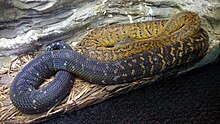
Amazon parrots are parrots in the genus Amazona. They are medium-sized, short-tailed parrots native to the Americas, with their range extending from South America to Mexico and the Caribbean. Amazona is one of the 92 genera of parrots that make up the order Psittaciformes and is in the family Psittacidae, one of three families of true parrots. It contains about thirty species. Most amazons are predominantly green, with accenting colors that depend on the species, and they can be quite vivid. They feed primarily on seeds, nuts, and fruits, supplemented by leafy matter.

The yellow-shouldered amazon, also known as the yellow-shouldered parrot, is a parrot of the genus Amazona that is found in the arid areas of northern Venezuela, the Venezuelan islands of Margarita and La Blanquilla, and the island of Bonaire. It has been extirpated from Aruba and introduced to Curaçao.

The black-billed amazon is a parrot endemic to Jamaica. Sometimes called the black-billed parrot, this amazon parrot is mostly green with small patches of red on the wing and sometimes flecked on the head. Its bill makes it easy to separate from most other amazons, including the yellow-billed amazon, which also lives in Jamaica. It is the smallest Amazona parrot at 25 cm (10 in).

The Puerto Rican boa is a large species of boa endemic to Puerto Rico. It is a terrestrial snake with a dark brown coloration. It grows to 1.9 m (6.2 ft) in length. It feeds on small mammals such as rodents and bats, birds and sometimes anole lizards. Like most boas, it is viviparous and kills its prey using constriction.

The Puerto Rican amazon, also known as the Puerto Rican parrot or iguaca, is the only extant parrot endemic to the archipelago of Puerto Rico, and belongs to the Neotropical genus Amazona. Measuring 28–30 cm (11.0–11.8 in), the bird is a predominantly green parrot with a red forehead and white rings around the eyes. Its closest relatives are believed to be the Cuban amazon and the Hispaniolan amazon.

The fauna of Puerto Rico is similar to other island archipelago faunas, with high endemism, and low, skewed taxonomic diversity. Bats are the only extant native terrestrial mammals in Puerto Rico. All other terrestrial mammals in the area were introduced by humans, and include species such as cats, goats, sheep, the small Indian mongoose, and escaped monkeys. Marine mammals include dolphins, manatees, and whales. Of the 349 bird species, about 120 breed in the archipelago, and 47.5% are accidental or rare.

The Jamaican dry forests is a tropical dry forest ecoregion located in southern Jamaica.
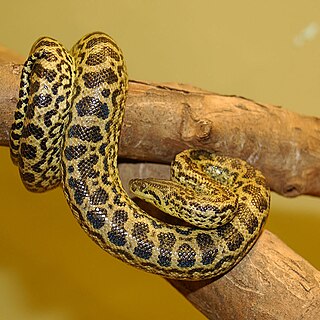
The yellow anaconda, also known as the Paraguayan anaconda, is a boa species endemic to southern South America. It is one of the largest snakes in the world but smaller than its close relative, the green anaconda. No subspecies are currently recognized. Like all boas and pythons, it is non-venomous and kills its prey by constriction.

The red-tailed amazon, also known as the red-tailed parrot, is a species of parrot in the family Psittacidae. It is endemic to coastal regions in the south-east Brazilian states of São Paulo and Paraná. The bird has been threatened by habitat loss and capture for the wild bird trade, and is a symbol of the efforts to conserve one of the Earth's most biologically diverse ecosystems. Consequently, it is considered Near Threatened by BirdLife International and the IUCN. In 1991–92, the population had fallen below 2000 individuals. Following on-going conservation efforts, a count and estimate from 2015 suggests a population of 9,000–10,000, indicating that this species is recovering from earlier persecution. A recent study shows that the population of this species is stable at Paraná state, Southern Brazil, revealing population trend fluctuation during the last 12 years.

The yellow-billed amazon, also called the yellow-billed parrot or Jamaican amazon, is a species of parrot in the family Psittacidae. It is a predominantly green parrot with a short tail and pink throat and neck. It is endemic to Jamaica, where its natural habitats are subtropical or tropical moist lowland forests, subtropical or tropical mangrove forests, subtropical or tropical moist montane forests, plantations, and rural gardens. It is threatened by habitat loss and illegal trapping of wild birds for the pet trade.

The Cuban boa, also known as the Cuban tree boa and by locals as majá de Santa María, is a very large species of snake in the family Boidae. With lengths exceeding 5 m (16 ft) and a relatively heavy build, the Cuban boa is one of the largest snakes in the world. The species is native to Cuba and some nearby islands. No subspecies are currently recognized.
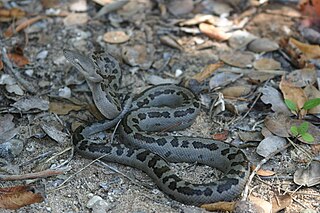
Chilabothrus chrysogaster, commonly known as the Turks and Caicos Islands boa or the Southern Bahamas boa, is a species of snake found in the Southern Bahamas and the Turks and Caicos Islands. Local names include the rainbow boa, the Bahamas cat boa, the rainbow snake, and the fowl snake. Like all boids, it is not a venomous species.

Chilabothrus monensis, also called commonly the Virgin Islands boa in the Virgin Islands, and the Mona Island boa elsewhere, is a species of snake in the family Boidae. The species is native to the West Indies. There are no subspecies.
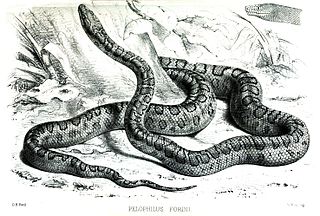
Chilabothrus fordii, also known commonly as Ford's boa and the Haitian ground boa, is a species of snake in the family Boidae. There are three recognized subspecies.
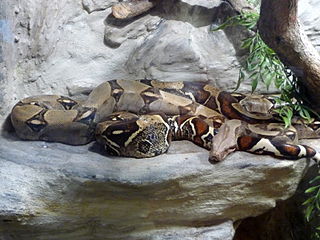
The boa constrictor, also known as the common boa, is a species of large, non-venomous, heavy-bodied snake that is frequently kept and bred in captivity. The boa constrictor is a member of the family Boidae. The species is native to tropical South America. A staple of private collections and public displays, its color pattern is highly variable yet distinctive. Four subspecies are recognized.
Chilabothrus schwartzi, also known as the Crooked-Acklins boa or Crooked Aklins boa, is a species of snake. It is endemic to the southern Bahamas, specifically to Crooked Island and Acklins. It was originally described as a subspecies of Epicrates chrysogaster, but it was elevated to full species status in 2018. In fact, molecular data suggest a closer relationship with Chilabothrus argentum than with Chilabothrus chrysogaster.

Mona and Monito Islands Nature Reserve consists of two islands, Mona and Monito, in the Mona Passage off western Puerto Rico in the Caribbean. Mona and Monito Islands Nature Reserve encompasses both land and marine area, and with an area of 38,893 acres it is the largest protected natural area in the Commonwealth of Puerto Rico. Much like the Galapagos Islands in the Pacific Ocean, the Mona and Monito Islands reserve represents a living laboratory for archaeological, biological, geological, oceanographical and wildlife management research.
Chilabothrus granti, also known commonly as the Virgin Islands boa, is a species of snake in the family Boidae. The species is native to the Caribbean.

Chilabothrus strigilatus, also known commonly as the Bahamian boa, is a species of snake in the family Boidae. The species is endemic to the Bahamas. There are five recognized subspecies.
